A Deep Learning-Based Three-Stage Method for Spillway Blockage Detection in Reservoirs
Abstract
1. Introduction
- Due to the complex and variable weather conditions in a reservoir, the rain and fog generated around the spillway will pose certain difficulties in detecting foreign object blockages. Therefore, a rain and fog interference removal algorithm is proposed to denoise the image and improve its quality.
- For the recognition scenario of a reservoir spillway environment, an improved DeepLabv3+ spillway boundary segmentation algorithm is proposed to avoid interference from objects in nonspillway areas. This algorithm enhances the recognition ability of spillway boundary areas via a lightweight backbone network and by introducing a CFF module, providing more accurate feature input for subsequent foreign object detection.
- In order to enhance the feature extraction and capture capabilities of the network, an improved YOLOv7 foreign object blockage target detection algorithm is proposed. By reconstructing the efficient backbone network and introducing the SPPFCSPC-M module, the interference of non-target features is effectively suppressed, and the accuracy of blockage recognition is improved.
- We implemented the rain and fog interference removal algorithm, spillway boundary area segmentation algorithm, and foreign object blockage target detection algorithm, and developed a three-stage detection method to enhance image clarity and eliminate extraneous interference factors outside the spillway area, thereby achieving precise recognition of blockage targets in intricate environments.
2. Three-Stage Reservoir Spillway Blockage Detection Method Based on Deep Learning
2.1. Rain and Fog Interference Removal Algorithm
2.1.1. Dark Channel Prior Algorithm
2.1.2. Global Histogram Equalization Algorithm
2.2. Spillway Boundary Region Segmentation Algorithm Based on Improved DeepLabv3+
2.2.1. Improved DeepLabv3+ Algorithm Network Architecture
2.2.2. Lightweight Backbone Network
2.2.3. Improvement of Feature Fusion Network by Combining CFF Module
2.3. Blocked Target Detection Algorithm Based on Improved YOLOv7
2.3.1. Improved YOLOv7 Algorithm Network Architecture
2.3.2. Efficient Backbone Network Construction
2.3.3. Improved Spatial Pyramid Pooling Cross-Local Stage Convolution Module
3. Experimental Results and Analysis
3.1. Experimental Preprocessing and Training Parameter Setting
3.2. Experimental Results and Comparative Analysis
3.2.1. Analysis of Spillway Boundary Area Segmentation Performance
3.2.2. Single-Stage Model Spillway Blockage Target Detection Performance and Comparative Analysis
3.2.3. Cascade Model Spillway Blockage Detection Performance and Comparative Analysis
3.2.4. Performance and Comparative Analysis of Blockage Recognition in Complex Rain and Fog Environment
4. Conclusions and Discussion
Author Contributions
Funding
Data Availability Statement
Acknowledgments
Conflicts of Interest
References
- Pandey, M.C.; Lubis, M.Z.; Permana, A.; Pamungkas, S.D.; Adam, M. Application on Survey Implementation of Dredging and Structure for Energy Reducing Spillway Building at Ladongi Dam. In Proceedings of the 3rd International Conference on Applied Engineering (ICAE 2020), Batam, Indonesia, 7–8 October 2020; pp. 40–47. [Google Scholar]
- Bénet, L.; De Cesare, G.; Pfister, M. Reservoir level rise under extreme driftwood blockage at ogee crest. J. Hydraul. Eng. 2021, 147, 04020086. [Google Scholar] [CrossRef]
- Xiang, Y.; Fu, Z.; Liu, C.; Zhang, K.; Wang, Y.; Shen, G. Dam Safety On-site Inspection and Test. In On-Site Inspection and Dam Safety Evaluation; Springer Nature: Singapore, 2024; pp. 23–101. [Google Scholar]
- Cheng, X.T. Lessons from and reflections on the case of Guojiazui Reservoir caused by the “July 20” extremely heavy rainstorm in Zhengzhou in 2021. China’s Flood Drought Prev. 2022, 32, 32–36. (In Chinese) [Google Scholar]
- Lohumi, K.; Roy, S. Automatic detection of flood severity level from flood videos using deep learning models. In Proceedings of the 2018 5th International Conference on Information and Communication Technologies for Disaster Management (ICT-DM), Sendai, Japan, 4–7 December 2018. [Google Scholar]
- Vallimeena, P.; Gopalakrishnan, U.; Nair, B.B.; Rao, S.N. CNN algorithms for detection of human face attributes—A survey. In Proceedings of the 2019 International Conference on Intelligent Computing and Control Systems (ICCS), Madurai, India, 15–17 May 2019. [Google Scholar]
- Feng, C.; Zhang, H.; Wang, H.; Wang, S.; Li, Y. Automatic pixel-level crack detection on dam surface using deep convolutional network. Sensors 2020, 20, 2069. [Google Scholar] [CrossRef] [PubMed]
- Yokoya, N.; Yamanoi, K.; He, W.; Baier, G.; Adriano, B.; Miura, H.; Oishi, S. Breaking limits of remote sensing by deep learning from simulated data for flood and debris-flow mapping. IEEE Trans. Geosci. Remote Sens. 2020, 60, 4400115. [Google Scholar] [CrossRef]
- Basnyat, B.; Roy, N.; Gangopadhyay, A. Flood detection using semantic segmentation and multimodal data fusion. In Proceedings of the 2021 IEEE international conference on pervasive computing and communications workshops and other affiliated events (PerCom Workshops), Kassel, Germany, 22–26 March 2021. [Google Scholar]
- Yang, K.; Zhang, S.; Yang, X.; Wu, N. Flood Detection Based on Unmanned Aerial Vehicle System and Deep Learning. Complexity 2022, 2022, 6155300. [Google Scholar] [CrossRef]
- Lin, J.; Zhan, H.; Lu, Y.; Yang, C.; Zhang, Z.; Wang, X.; Zhang, Z.; Lai, G. A Garbage Recognition Algorithm Based on YoloX Using in Flood Control System. In Proceedings of the 2022 5th International Conference on Pattern Recognition and Artificial Intelligence (PRAI), Chengdu, China, 19–21 August 2022. [Google Scholar]
- Kazemi Garajeh, M.; Weng, Q.; Hossein Haghi, V.; Li, Z.; Kazemi Garajeh, A.; Salmani, B. Learning-based methods for detection and monitoring of shallow flood-affected areas: Impact of shallow-flood spreading on vegetation density. Can. J. Remote Sens. 2022, 48, 481–503. [Google Scholar] [CrossRef]
- Li, X.Y.; Sun, C.M.; Wei, Y.; Yuan, Y.; Wu, Z.B. Intelligent detection method for water level in harsh scenes by integrating Transformer and residual channel attention. J. Electron. Meas. Instrum. 2023, 37, 59–69. (In Chinese) [Google Scholar]
- Qiu, Z.G. Research on Image Detection Algorithm for Cracks in Low Light Underwater Dams. Master’s Thesis, North China University of Water Resources and Electric Power, Zhengzhou, China, 2022. (In Chinese). [Google Scholar]
- Wu, X.; Li, J. Deep learning-based siltation image recognition of water conveyance tunnels using underwater robot. J. Civ. Struct. Health Monit. 2024, 14, 801–816. [Google Scholar] [CrossRef]
- Feng, C.; Zhang, H.; Li, Y.; Wang, S.; Wang, H. Efficient real-time defect detection for spillway tunnel using deep learning. J. Real-Time Image Process. 2021, 18, 2377–2387. [Google Scholar] [CrossRef]
- Zhang, J.; Tian, F.; Li, T.; Lan, H. A Surface Crack Detection Method of Spillway Tunnel Based on an Improved U-Net Network. In Proceedings of the 2022 5th International Conference on Pattern Recognition and Artificial Intelligence (PRAI), Xiamen, China, 23–25 September 2022; IEEE: Piscataway, NJ, USA, 2022; pp. 845–850. [Google Scholar]
- Wan, C.; Li, F.; Yu, W.; Chen, A.; Li, P. Intelligent Recognition of Structures in Earth and Rock Dam Images Based on Mask-RCNN. In Proceedings of the 2024 Asia-Pacific Conference on Image Processing, Electronics and Computers (IPEC), Dalian, China, 12–14 April 2024; IEEE: Piscataway, NJ, USA, 2024; pp. 55–59. [Google Scholar]
- Iqbal, U.; Riaz, M.Z.B.; Barthelemy, J.; Hutchison, N.; Perez, P. Floodborne Objects Type Recognition Using Computer Vision to Mitigate Blockage Originated Floods. Water 2022, 14, 2605. [Google Scholar] [CrossRef]
- Vandaele, R.; Dance, S.L.; Ojha, V. Deep learning for automated trash screen blockage detection using cameras: Actionable information for flood risk management. J. Hydroinformatics 2024, 26, 889–903. [Google Scholar] [CrossRef]
- Narasimhan, S.G.; Nayar, S.K. Vision and the atmosphere. Int. J. Comput. Vis. 2002, 48, 233–254. [Google Scholar] [CrossRef]
- He, K.; Sun, J.; Tang, X. Single image haze removal using dark channel prior. IEEE Trans. Pattern Anal. Mach. Intell. 2010, 33, 2341–2353. [Google Scholar] [PubMed]
- Li, L.J.; Chen, F.F. Infrared image enhancement method based on improved histogram. Aviat. Weapon 2022, 29, 101–105. (In Chinese) [Google Scholar]
- Zhu, J.R. Research on Optimization Method of Image Segmentation Edge Effect Based on Deep Learning. Master’s Thesis, Harbin Institute of Technology, Harbin, China, 2021. (In Chinese). [Google Scholar]
- Sandler, M.; Howard, A.; Zhu, M.; Zhmoginov, A.; Chen, L.C. Mobilenetv2: Inverted residuals and linear bottlenecks. In Proceedings of the 2018 IEEE/CVF Conference on Computer Vision and Pattern Recognition, Salt Lake City, UT, USA, 18–23 June 2018; pp. 4510–4520. [Google Scholar]
- Zhao, H.; Qi, X.; Shen, X.; Shi, J. Icnet for real-time semantic segmentation on high-resolution images. In Proceedings of the European Conference on Computer Vision (ECCV), Munich, Germany, 8–14 September 2018; pp. 405–420. [Google Scholar]
- Girshick, R.; Donahue, J.; Darrell, T.; Malik, J. Region-based convolutional networks for accurate object detection and segmentation. IEEE Trans. Pattern Anal. Mach. Intell. 2015, 38, 142–158. [Google Scholar] [CrossRef] [PubMed]
- Liu, W.; Anguelov, D.; Erhan, D.; Malik, J. Ssd: Single shot multibox detector. In Proceedings of the Computer Vision–ECCV 2016: 14th European Conference, Amsterdam, The Netherlands, 11–14 October 2016; Proceedings, Part I 14. Springer International Publishing: Berlin/Heidelberg, Germany, 2016; pp. 21–37. [Google Scholar]
- Ross, T.Y.; Dollár, G. Focal loss for dense object detection. In Proceedings of the IEEE Conference on Computer Vision and Pattern Recognition, Honolulu, HI, USA, 21–26 July 2017; pp. 2980–2988. [Google Scholar]
- Wang, Q.; Wu, B.; Zhu, P.; Li, P.; Zuo, W.; Hu, Q. ECA-Net: Efficient channel attention for deep convolutional neural networks. In Proceedings of the IEEE/CVF Conference on Computer Vision and Pattern Recognition (CVPR), Seattle, WA, USA, 13–19 June 19 2020; pp. 11534–11542. [Google Scholar]
- Wang, Y. Identification and Defect Detection of Transmission Line Anti vibration Hammer Based on YOLOv7. Master’s Thesis, Northeast Agricultural University, Harbin, China, 2023. (In Chinese). [Google Scholar]


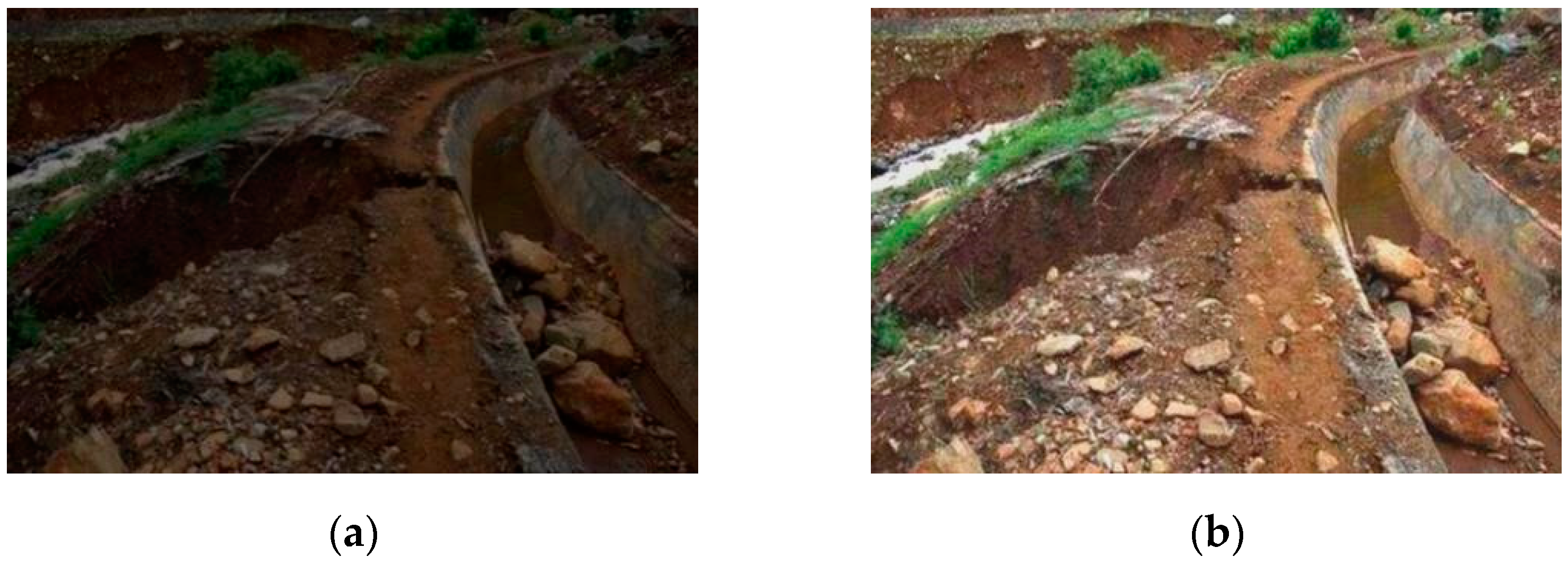
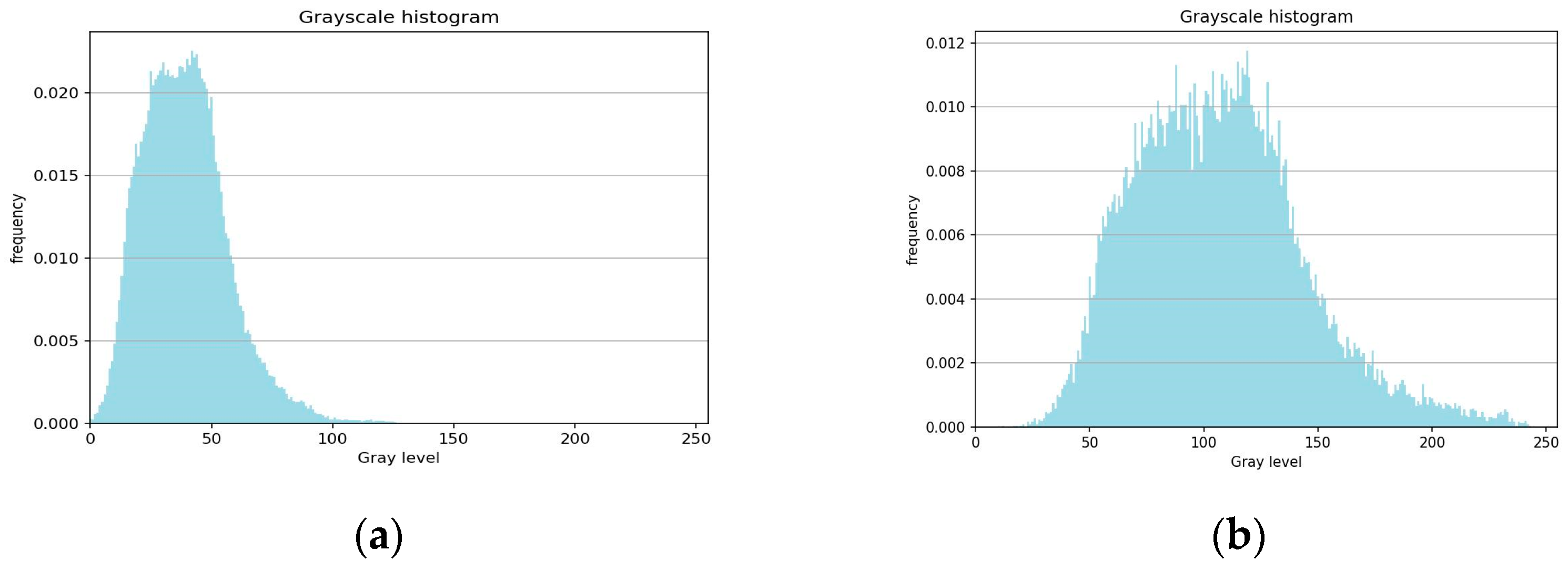
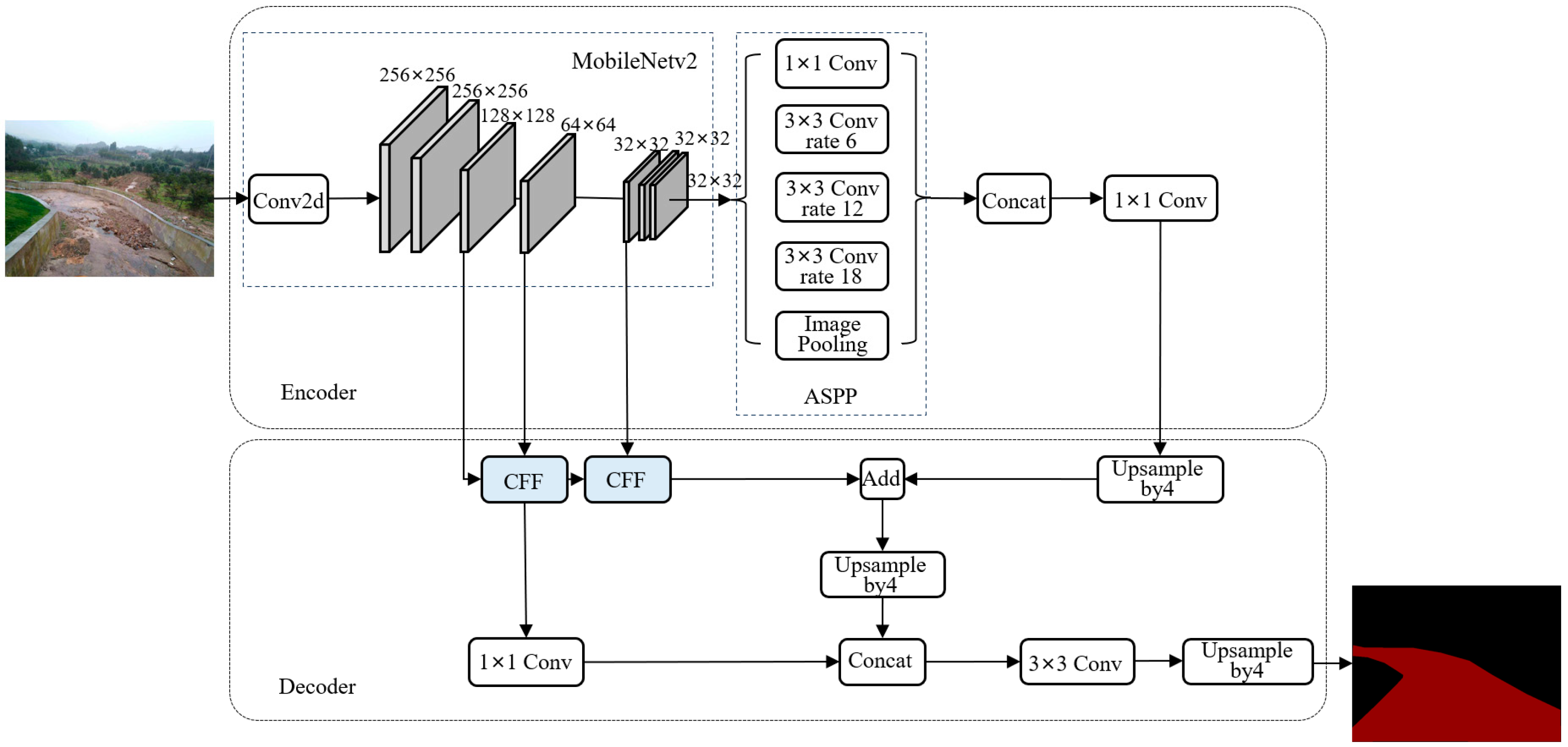


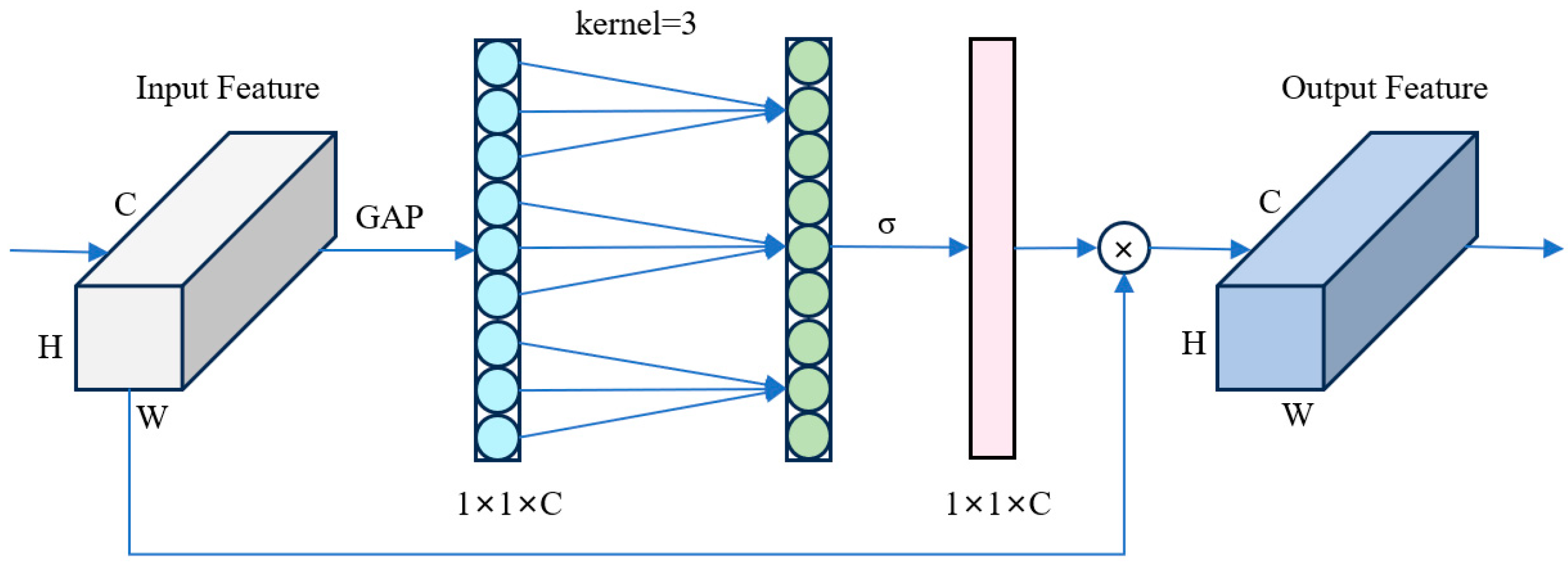

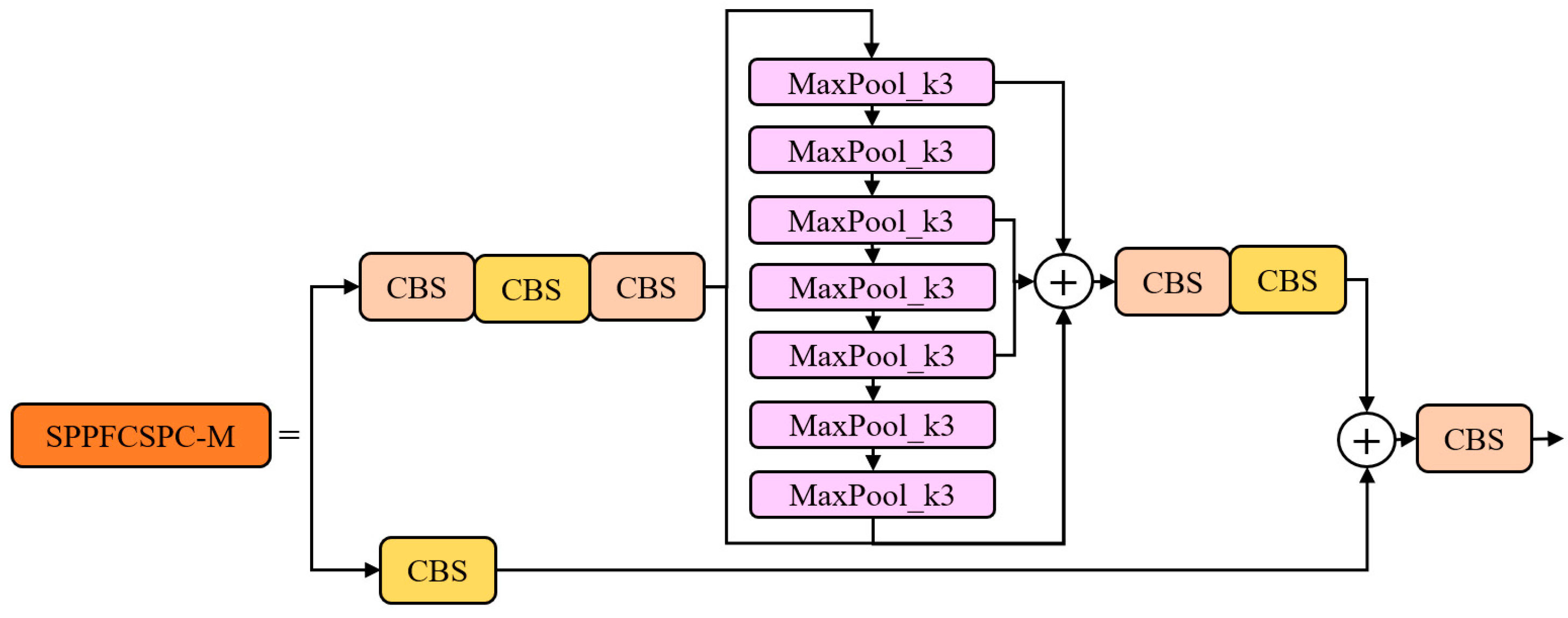
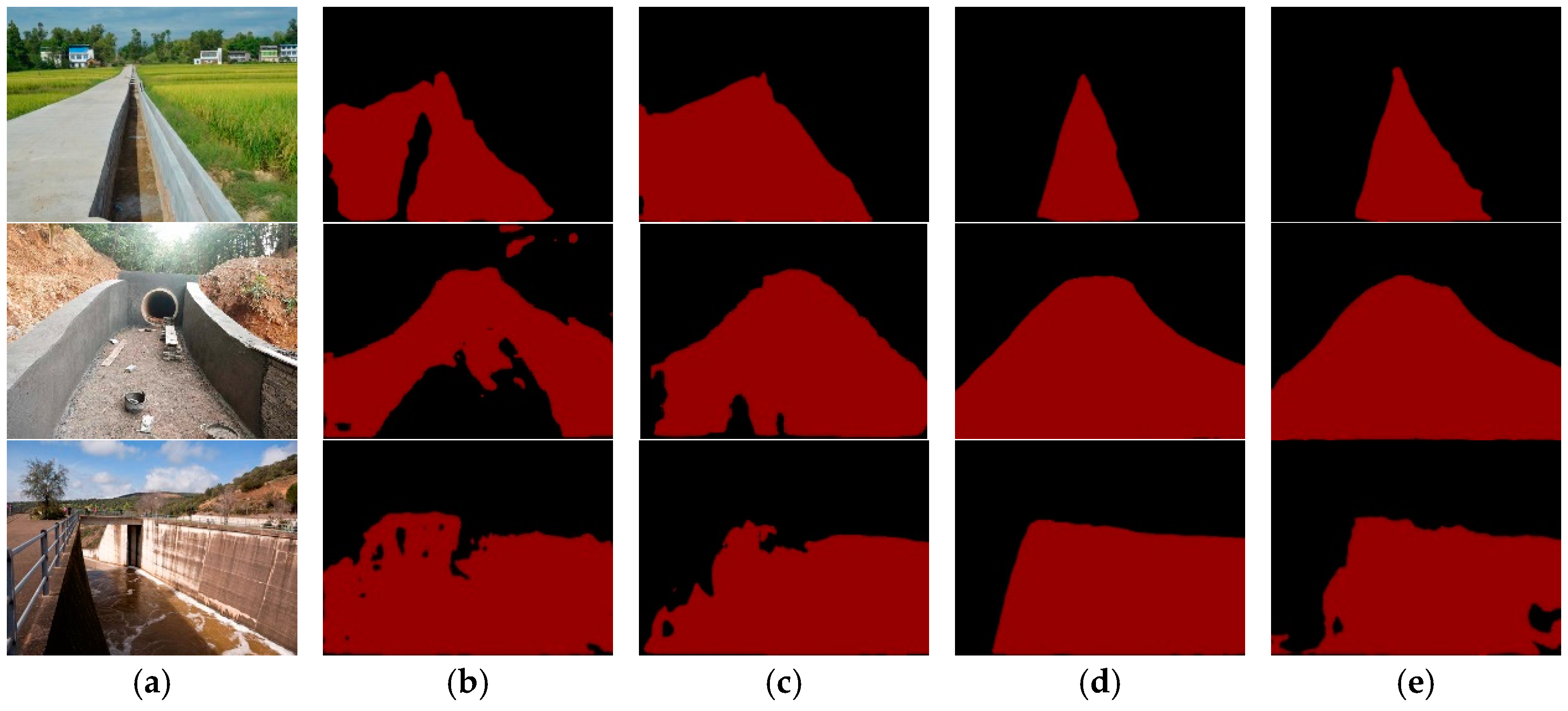



| Models | mPA/% | MIoU/% | Param/M | FPS/Hz |
|---|---|---|---|---|
| Unet | 93.16 | 86.99 | 24.892 | 51.97 |
| PSPnet | 93.77 | 88.44 | 46.716 | 102.67 |
| DeepLabv3+ | 97.51 | 95.13 | 54.709 | 67.97 |
| DeepLabv3+-MobileNetV2 | 96.28 | 92.60 | 5.813 | 141.12 |
| DeepLabv3+-MobileNetV2-CFF | 96.63 | 93.27 | 5.916 | 105.71 |
| Models | P/% | R/% | mAP/% | Param/M | FPS/Hz |
|---|---|---|---|---|---|
| SSD | 69.24 | 52.82 | 56.90 | 24.146 | 135.73 |
| YOLOv5 | 78.05 | 55.50 | 68.29 | 46.653 | 90.11 |
| YOLOv7 | 72.99 | 67.67 | 70.39 | 37.216 | 69.49 |
| YOLOv7 + ECA efficient backbone network | 75.64 | 68.62 | 73.35 | 37.216 | 64.51 |
| YOLOv7 + ECA efficient backbone network +SPPFCSPC-M | 74.30 | 71.56 | 73.93 | 37.478 | 73.87 |
| Models | P/% | R/% | mAP/% | FPS/Hz |
|---|---|---|---|---|
| YOLOv7 spillway blockage detection model before single-stage improvement | 72.99 | 67.67 | 70.39 | 69.49 |
| DeepLabv3+ and improved YOLOv7 cascade spillway blockage detection model before improvement | 82.18 | 74.22 | 79.76 | 66.77 |
| Improved DeepLabv3+ and improved YOLOv7 cascade spillway blockage detection model | 83.43 | 77.49 | 80.32 | 67.96 |
| Methods | P/% | R/% | mAP/% |
|---|---|---|---|
| Failure to eliminate rain and fog interference | 73.51 | 68.31 | 71.12 |
| CLAHE | 82.02 | 69.25 | 74.75 |
| DCP | 84.13 | 71.62 | 76.51 |
| Rain and fog interference removal algorithm | 83.08 | 73.55 | 77.77 |
| Methods | P/% | R/% | mAP/% | FPS/Hz |
|---|---|---|---|---|
| YOLOv7 with single-stage improvement | 80.92 | 68.66 | 73.61 | 73.87 |
| Two stages (improved YOLOv7 and improved DeepLabv3+) | 73.51 | 68.31 | 71.12 | 67.96 |
| Two stages (rain and fog interference removal algorithm and improved YOLOv7) | 79.88 | 71.63 | 75.31 | 67.66 |
| Three stages (rain and fog interference removal algorithm, improved YOLOv7, and improved DeepLabv3+) | 83.08 | 73.55 | 77.77 | 66.46 |
Disclaimer/Publisher’s Note: The statements, opinions and data contained in all publications are solely those of the individual author(s) and contributor(s) and not of MDPI and/or the editor(s). MDPI and/or the editor(s) disclaim responsibility for any injury to people or property resulting from any ideas, methods, instructions or products referred to in the content. |
© 2024 by the authors. Licensee MDPI, Basel, Switzerland. This article is an open access article distributed under the terms and conditions of the Creative Commons Attribution (CC BY) license (https://creativecommons.org/licenses/by/4.0/).
Share and Cite
Xu, X.; Bao, X.; Wang, Y.; Wang, H. A Deep Learning-Based Three-Stage Method for Spillway Blockage Detection in Reservoirs. Water 2024, 16, 3396. https://doi.org/10.3390/w16233396
Xu X, Bao X, Wang Y, Wang H. A Deep Learning-Based Three-Stage Method for Spillway Blockage Detection in Reservoirs. Water. 2024; 16(23):3396. https://doi.org/10.3390/w16233396
Chicago/Turabian StyleXu, Xiaohua, Xuecai Bao, Yining Wang, and Haijing Wang. 2024. "A Deep Learning-Based Three-Stage Method for Spillway Blockage Detection in Reservoirs" Water 16, no. 23: 3396. https://doi.org/10.3390/w16233396
APA StyleXu, X., Bao, X., Wang, Y., & Wang, H. (2024). A Deep Learning-Based Three-Stage Method for Spillway Blockage Detection in Reservoirs. Water, 16(23), 3396. https://doi.org/10.3390/w16233396






